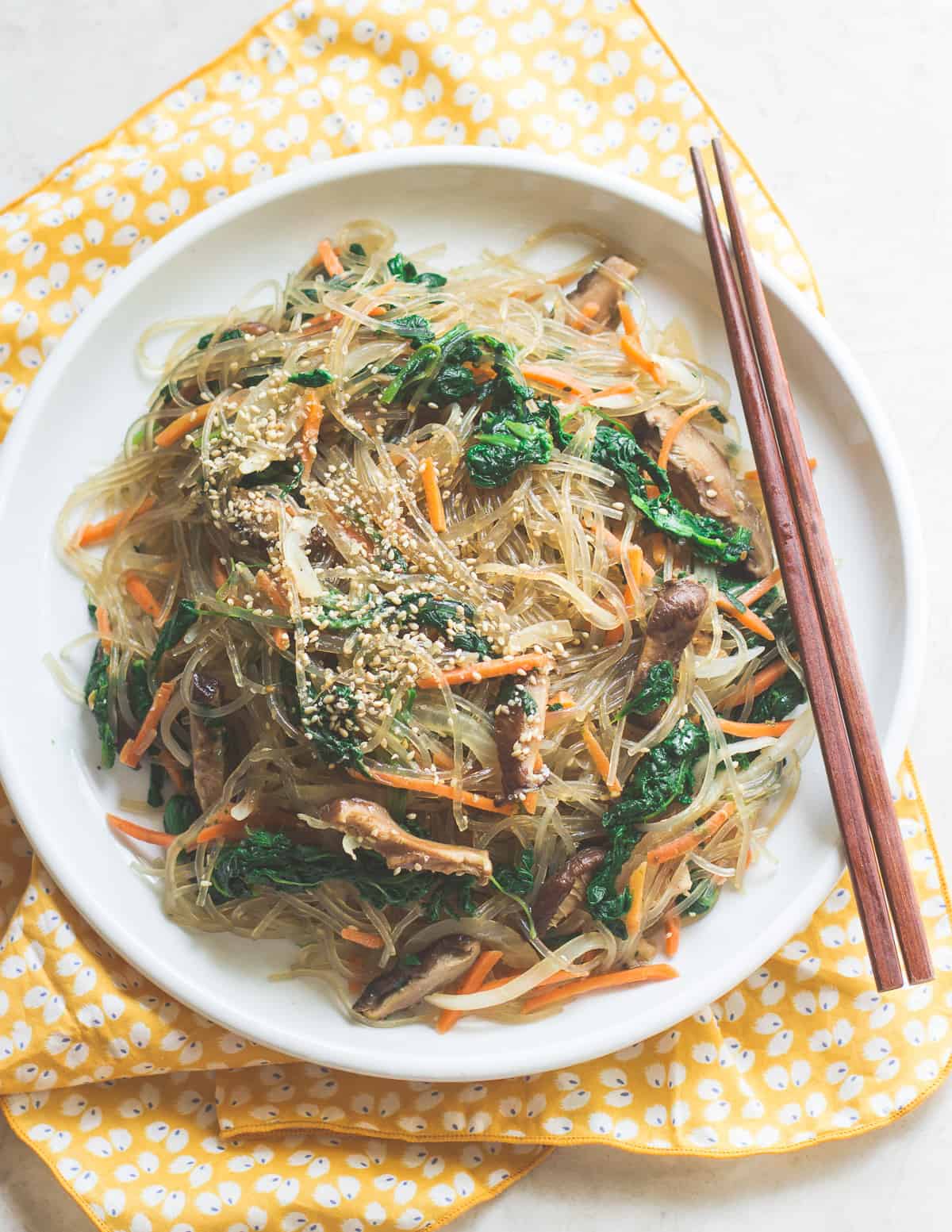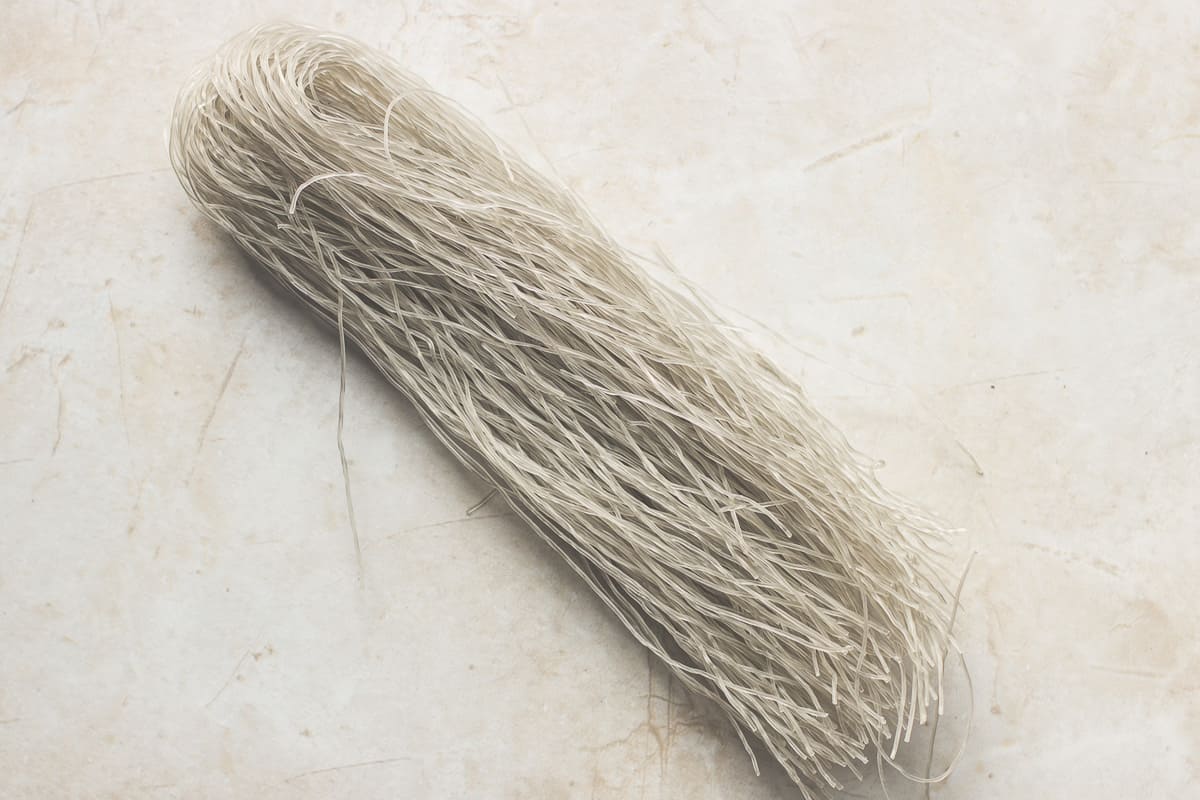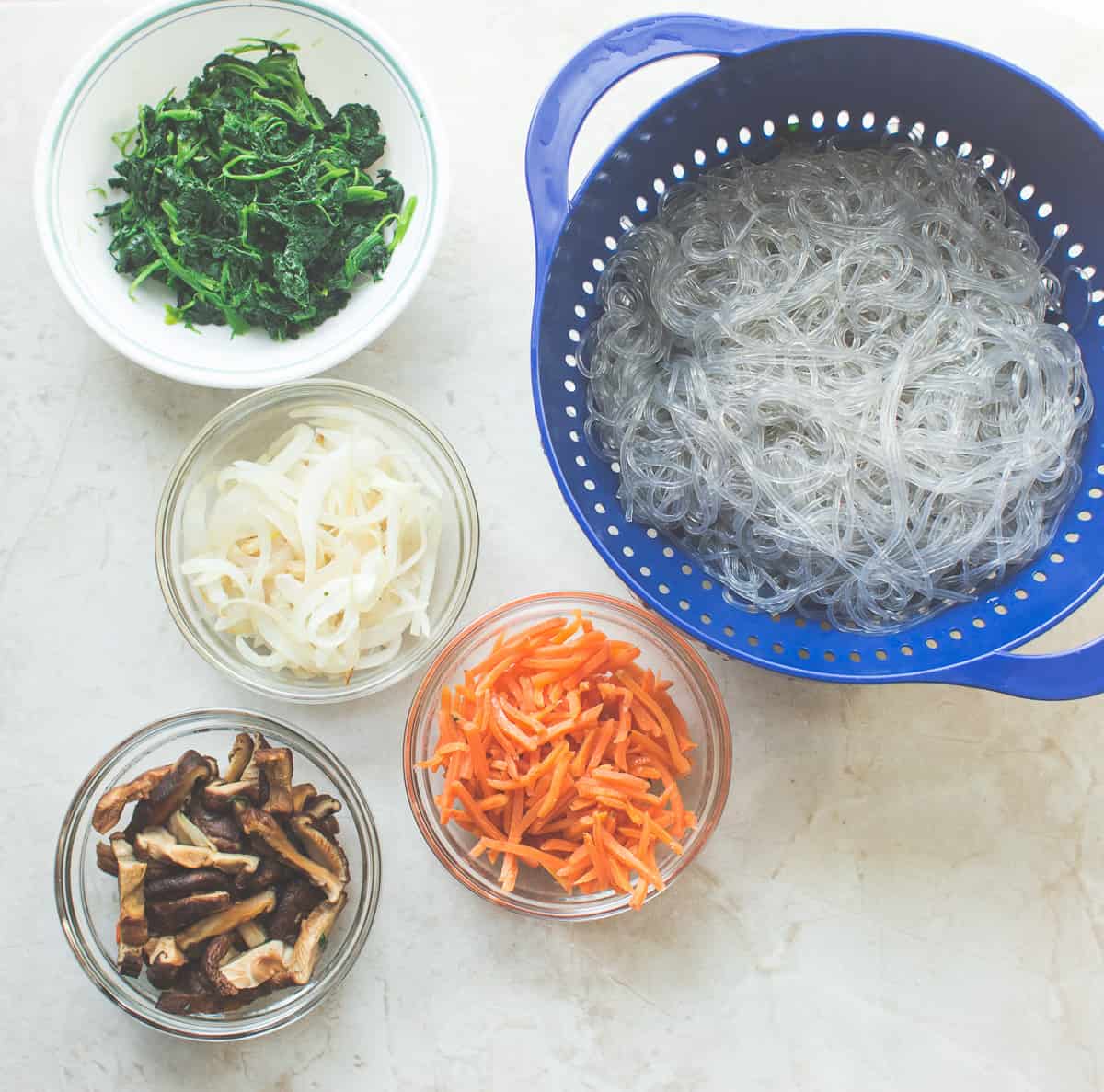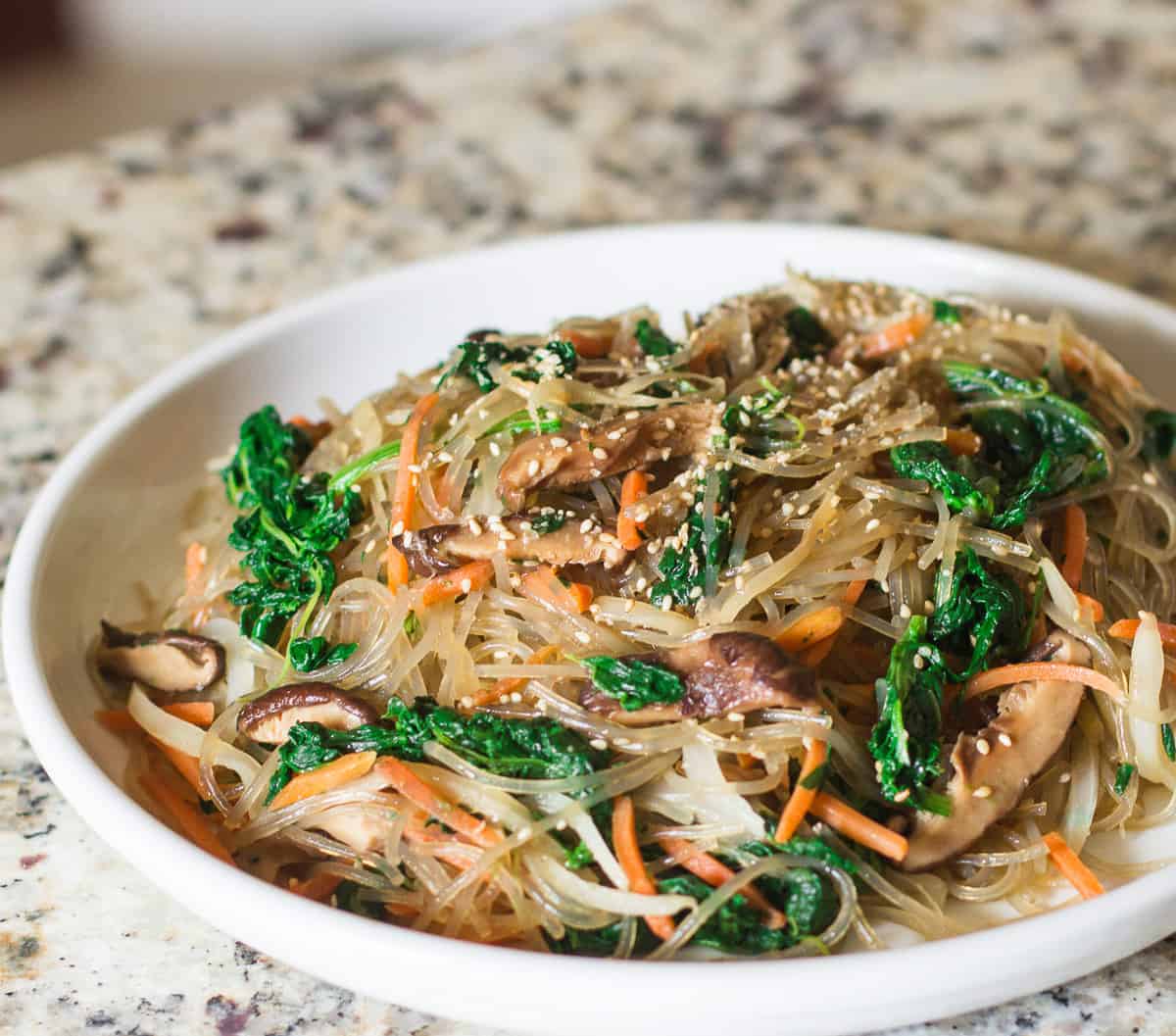This post may contain affiliate links. Please see our disclosure policy for more details.
It is so easy to make this vegetarian japchae, featuring stir-fried glass noodles, vibrant vegetables, and a savory sauce bursting with flavor. It’s perfect for special occasions and as an everyday side dish or main meal.

Vegetarian Japchae Recipe
I will forever associate this traditional Korean noodle dish with my mom who was known as the “japchae queen” amongst our community growing up.
And I can confidently say that you seriously haven’t had japchae until you’ve tried my mom’s! It is simply the best, and I absolutely refuse to order it at Korean restaurants.
I’ve asked her to write down the recipe so I can include it in my “Beloved Family Recipes” collection to pass down to my children someday, but she always tells me to move by feel, taste as I go, and as for the seasoning, just eyeball it!
Said like a true Korean home cook.
So the best I could do is to watch her every move like hawk as I have been doing for many years. And because I love you guys, I measured the seasoning to the best of my ability, but I do have to agree with mom on this one:
These kinds of dishes turn out best when you move by feel, allowing your taste buds to guide you. In other words, don’t make this when you are sick :).
Ingredients


- Korean sweet potato noodles – also called dangmyeon, Korean vermicelli or glass noodles. Made from sweet potato starch, these noodles, once cooked, are chewy and springy. You will easily find them at Asian grocery stores.
- Fresh vegetables – While you can add whatever veggies you wish, the most popular ones include onion, carrots, and red bell peppers.
- Shiitake mushrooms – this is a must in my opinion as it provides a meaty flavor to the dish.
- Japchae sauce – a combination of soy sauce, sesame oil, and brown sugar or honey to create the perfect balance of sweet and savory notes
Step-by-Step Instructions

While making Korean stir-fried glass noodles may seem complex due to the number of steps involved, once you understand the cooking process, it becomes relatively straightforward to make.
It primarily involves cooking glass noodles, stir-frying vegetables, and combining them with japchae sauce.
- Cut all the ingredients into thinly sliced/julienned strips. I love to use my mandolin for this as it makes the process go super quick.
- Bring a large pot of water to a boil. Add spinach and cook for a few seconds, until the spinach has wilted. Remove immediately and rinse in cold water. Don’t discard the water. You’re going to use it for the noodles.
- Drain and gently squeeze out all the water from spinach. Form into a ball, then using kitchen shears, cut it in half. Combine spinach with 1 teaspoon of sesame oil and pinch of salt. Set aside.
- Add noodles to the same pot with boiling water and and cook for 6-8 minutes until softened and chewy. It should NOT be al dente! Drain and rinse under cold water. Using scissors, cut the noodles into shorter lengths, about 8 inches. Toss with 1 teaspoon sesame oil and set aside.
- In a small bowl, mix soy sauce, sugar (or maple syrup), and sesame oil together until sugar dissolves. Set aside.
- Heat 1 teaspoon of neutral oil in a large skillet over medium high heat. Add onion. Stir-fry for about 2 minutes, or until onion is slightly translucent. Remove from pan.
- In the same skillet, repeat the whole process with carrots and mushrooms.
- In a large mixing bowl, add the cooked noodles and all the vegetables. Pour in the japchae sauce. Using your hands toss until all the ingredients are coated evenly with the sauce. Taste and season with salt, if needed. Add the toasted sesame seeds and a drizzle of sesame oil. Transfer to a large plate and enjoy immediately.

A Shortcut Method
One rule that my mom stressed is to cook the colorful vegetables separately so that each and every ingredient retains its maximum flavor, color, and texture without blending with the other ingredients.
BUT as a busy mom of two littles, time is a precious commodity, so I came up with my shortcut—One-Pot Japchae. This is how I usually make it, and guess what? When I made it for my mom, even she was impressed!
Here’s how to make it!

Step 1: In a large pan, boil the sweet potato noodles for 6–8 minutes until they’re soft and chewy (not al dente!). Drain, rinse under cold water, and set aside. In the same pan, wipe it down and heat 1 tablespoon of sesame oil. Add thinly sliced onions and julienned carrots, and stir-fry until softened.

Step 2: Pour in japchae sauce (recipe at the bottom of the post), 1/4 cup of water, then add the cooked noodles. Let the mixture come to a gentle boil, allowing the noodles to soak up the flavor.

Step 3: Add the sliced mushrooms and fresh spinach. Cover the pan to let everything steam together for a couple of minutes.

Step 4: Drizzle with more sesame oil and sprinkle with sesame seeds for that nutty finish.
Recipe Tips
- Don’t overcook the vegetables. You want them to be tender-crisp in texture as it adds a great contrast from chewy glass noodles.
- I love sesame oil so I’m quite heavy handed with it, but again, you can decide how little or how much to add.
- Let my recipe serve as a guide. Along with adjusting the seasoning to your liking, You can add other vegetables, like sweet bell pepper, bean sprouts (which my mom often adds), or just keep it really simple with 1 or 2 ingredients.
Serving Suggestions

Japchae is a versatile dish that can be enjoyed warm, at room temperature, or cold!
Here are some suggestions:
- Main meal – enjoy with a side of kimchi.
- Side dish – pairs especially well with bulgogi, mandu (Korean dumplings), and vegetable pancakes.
- Bento Box – For a well-rounded meal on the go, you can include alongside other items like rice, protein, and additional vegetable sides. Here are more delicious bento box lunch ideas.
- Cold noodle salad – garnish with some fresh herbs like cilantro or green onion. Serve alongside miso tofu!
Storage Suggestions
Transfer leftovers to an airtight container and refrigerate for 2-3 days. Reheat in a pan on the stovetop over medium heat. Add a splash of water to prevent the noodles from drying out and stir-fry until heated through.
You can also microwave. Note that reheated japchae will be slightly softer in texture compared to when freshly cooked. It will still be delicious though!
More Korean Recipes
More Korean Recipes
Did you make this recipe? Leave a rating below and let me know how you liked the recipe! Your feedback means so much to me!

Vegetarian Japchae
Ingredients
- 6 ounces dried Korean sweet potato vermicelli noodles, dangmyeon
- 1 teaspoon sesame oil
- 1 tablespoon neutral oil
- 1 small onion, sliced
- 1 carrot, peeled and shredded (I used a pre-shredded one)
- 6 dried shitake mushrooms, soaked in warm water and cut into matchstick strips
- 1 bunch of spinach
- 4 tablespoons low-sodium soy sauce
- 1 tablespoon oyster sauce (optional)
- 1 tablespoon brown sugar or maple syrup or honey
- 2 tablespoon sesame oil
- salt
- toasted sesame seeds
Instructions
- In a pot, bring water to a boil. Add spinach and cook for a few seconds, until the spinach has wilted. Remove immediately and rinse in cold water. Don't discard the water. You're going to use it for the noodles.Drain and gently squeeze out all the water from spinach. Form into a ball, then using scissors, cut it in half. Combine spinach with 1 teaspoon of sesame oil and pinch of salt. Set aside.
- Add noodles to the pot and and cook for 6-8 minutes until softened and chewy. It should NOT be al dente! Drain and rinse under cold water. Using scissors, cut the noodles into shorter lengths, about 8 inches. Toss with 1 teaspoon sesame oil and set aside.
- In a small bowl, mix soy sauce, sugar, and sesame oil together until sugar dissolves. Set aside.
- Heat 1 teaspoon of neutral oil in a large skillet over medium high heat. Add onion. Stir-fry for about 2 minutes, or until onion is slightly translucent. Remove from pan.
- In the same skillet, repeat the whole process with carrots and mushrooms.
- In a large mixing bowl, add the noodles and all the vegetables. Pour in the soy sauce mixture. Using your hands toss until all the ingredients are coated evenly with the sauce. Taste and season with salt, if needed. Add the toasted sesame seeds and a drizzle of sesame oil. Serve immediately.





















This is a win win recipe in my house. The kids loved it and so do I. So easy to make and such a good flavor.